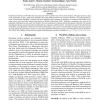126 search results - page 12 / 26 » Unsupervised word sense disambiguation using WordNet relativ... |
ACL
2006
13 years 8 months ago
2006
This paper presents a new approach based on Equivalent Pseudowords (EPs) to tackle Word Sense Disambiguation (WSD) in Chinese language. EPs are particular artificial ambiguous wor...
SAC
2005
ACM
14 years 28 days ago
2005
ACM
A great jump towards the advent of the Semantic Web will take place when a critical mass of web resources is available for use in a semantic way. This goal can be reached by the c...
ACL
1998
13 years 8 months ago
1998
In this paper we describe a method for performing word sense disambiguation (WSD). The method relies on unsupervised learning and exploits functional relations among words as prod...
LREC
2010
13 years 8 months ago
2010
Graph-based similarity over WordNet has been previously shown to perform very well on word similarity. This paper presents a study of the performance of such a graph-based algorit...
EMNLP
2010
13 years 5 months ago
2010
Graph-based methods have gained attention in many areas of Natural Language Processing (NLP) including Word Sense Disambiguation (WSD), text summarization, keyword extraction and ...

